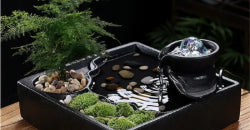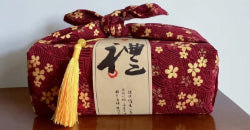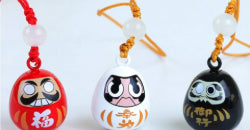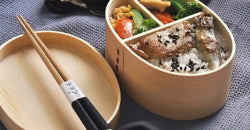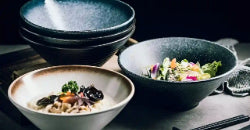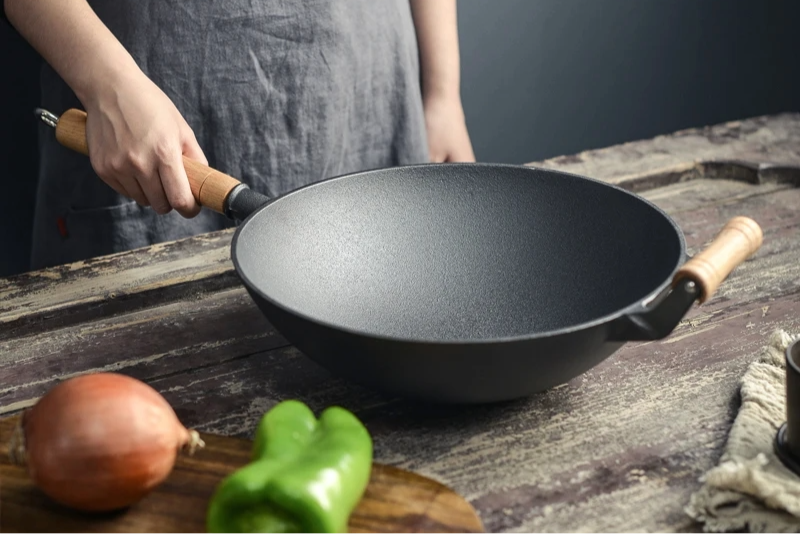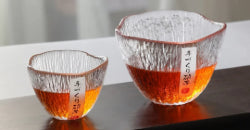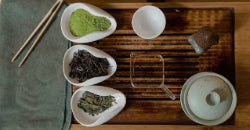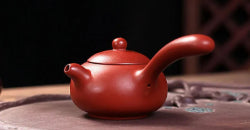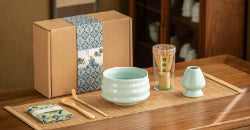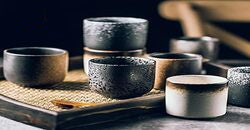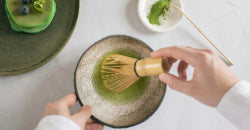Top 10 Japanese Cuisine Dishes

Source: Freepik
Rich in flavor and deeply rooted in Japanese cultural heritage, Japanese cuisine fascinates as much for the variety of its dishes as for the care taken in their presentation. Each dish tells a story, combining harmonious flavors and respect for the seasons. From Tokyo to Kyoto, certain specialties have become emblematic, combining ancestral know-how and gustatory pleasure. This review highlights ten dishes that illustrate Japan's culinary excellence.
Sushi: a perfect balance between finesse and tradition
An undeniable symbol of Japanese cuisine, sushi subtly combines the elegance of vinegared rice with the freshness of ingredients. Each bite rests on a carefully prepared rice base, to which are added raw fish, seafood, crunchy vegetables or eggs. Sushi is suitable for all occasions. Thanks to its diversity of shapes, it appeals to everyone's palate. We distinguish:
-
Temaki;
-
Makis;
-
Nigiri;
-
Chirashi;
-
Sashimi; and
-
California roll.
To fully enjoy these Japanese specialties, it's crucial to choose the right materials for their preparation. Discoverthe essentials you need in our Japanese tableware collection .
2. Japanese noodles: a tasty bridge between heritage and innovation
Noodles are a staple of Japanese cuisine. The three most popular varieties are soba, udon, and ramen. Each has its own unique texture, origins, and cooking style. The Japanese consume these noodles year-round. They are eaten hot in broth in winter or cold and light in summer. These dishes appeal to both the Japanese and Japanese food enthusiasts around the world.
Ramen is made with wheat flour. It is served in a meat or miso broth, with eggs, vegetables, or pork. Soba are noodles made from buckwheat flour. The Japanese enjoy them cold or in hot broth, especially during the New Year. Udon, which is thicker and chewier, offers a comforting side. Each region of Japan offers a unique variety of culinary specialties. This makes these noodleseven richer and more varied.
3. Miso soup: the daily ritual
Discreet, but essential, miso soup is a feature of almost every Japanese meal. This delicate and revitalizing soup is prepared by combining miso paste, made from fermented soybeans, with a traditional brothcalled dashi. Served as a side dish or starter, it harmoniously complements main dishes while respecting the balance of flavors. Its ingredients vary according to preferences and the seasons. We very often find
-
tofu;
-
wakame seaweed;
-
chives;
-
mushrooms; and
-
beef or shrimp.
Miso soup embodies the simplicity and finesse of traditional Japanese cuisine.
4. Tempura: the elegance of crispiness

Source: Freepik
Tempura are light frittersthat combine fine frying with delicate ingredients. The origin of this specialty dates back to Portuguese influence in the 16th century, but the Japanese have succeeded in making it a unique recipe, combining crunchiness, lightness, and natural flavor. The coating, made with a fluid, low-fat batter, keeps the food moist while giving it a delicious crispiness.
This dish can contain thinly sliced vegetables ( sweet potato, eggplant, carrot), fish (monkfish, cod) or seafood, especially shrimp, which are very popular. Tempura is often eaten with a bowl of white rice and a light soy-based sauce. In specialty restaurants, the fryingis done à la minute to guarantee freshness and perfect texture.
5. Onigiri: the essential snack
Both simple and practical, onigiriis a small snack prepared with rice, often wrapped in a sheet of nori seaweed. It can be shaped like a triangle or a ball, and can be filled with a variety of ingredients:
-
salted prune (umeboshi);
-
grilled salmon;
-
tuna mayonnaise; or even
-
marinated seaweed.
This ancestral food accompanies both everyday meals and outdoor outings.
In Japanese convenience stores, onigiri are ubiquitous, offering a wide range of flavors. Once consumed by warriors for its practicality, it remains today a staple of bento, the Japanese lunch boxes. Onigiri is the perfect example of a dish that is both traditional and modern, and fits into an active lifestyle.
6. Yakiniku: when meat becomes a spectacle

Source: Freepik
Yakiniku turns every meal into a truly gastronomic experience. This Japanese grilling concept involves directly cooking pieces of meatand vegetables, often done at the table, on an individual grill. The quality of the ingredients is paramount, particularly carefully selected wagyu beefor pork. Added to this is a selection of homemade sauces that enhance each bite. Here's what's often found in a yakiniku meal:
-
marinated beef slices;
-
grilled vegetables (peppers, mushrooms, onions);
-
offal or fine pieces;
-
tare sauce (sweet and salty soy) or lemon sauce; and
-
Accompaniments of rice or kimchi.
Yakiniku isas appealing for its conviviality as for the richness of its flavors. Each guest controls their cooking, making it a personalized and interactive experience. A beautiful illustration of the generosity of Japanese cuisine.
7. Okonomiyaki: the customizable pancake
Okonomiyaki, a culinary specialty born in Osaka, is a savory pancakethat can be customized to your liking, with a filling that varies according to individual tastes. Prepared with a base of cabbage, eggs, and flour, it can then be topped with a multitude of toppings such as seafood, pork, cheese, or vegetables. It is cooked on a hot plate and then turned with a spatula, sometimes even by the customer in some specialized restaurants.
This preparation offers great freedom: everyone can create their own version. Then, a thick, slightly sweet sauce is added, often accompanied by Japanese mayonnaise, powdered seaweed, and bonito flakes. There are two main variations: the Osaka version, which is more compact, and the Hiroshima version, which includes noodles. This family-friendly dish is also popular at Japanese festivals, where it is enjoyed on the go.
8. Karaage and tonkatsu: breaded pleasures

Source: Freepik
Among the rich palette of Japanese fried dishes, karaageand tonkatsu hold pride of place. The former refers to chicken marinated in ginger and soy sauce before being deep-fried. The latter is a breaded pork cutlet served with shredded cabbage and a sweet tonkatsu sauce. Both specialties are captivating with their golden crust and soft meat.
These dishes are found in both fast food restaurants and izakaya, Japanese bars where people share dishes over a drink. Karaage, crispy and juicy, is perfect for eating on the go. As for tonkatsu, it is often available as a sandwich or in a " katsudon" version, served on a bowl of rice with a beaten egg. Two different, but complementary ways to enjoy Japanese-style fried food.
9. Taiyaki: a cake that combines tradition and indulgence
Taiyaki is eye-catching due to its fish shape, often associated with sea bream, asymbol of prosperity in Japan. This small golden cake consists of a fluffy, pancake-like batter baked in a fish-shaped mold. Inside, a sweet filling such as chocolate, custard ,or red bean paste (anko) is placed. Each bite offers a pleasant contrast between the crispy exterior and the soft center.
The Japanese enjoy taiyaki at festivals, shopping streets, and street vendors. A few establishments have made it their trademark, offering modern versions, sometimes iced or savory. This little cake embodies a sweet treat that's both playful and rooted in popular culture. In just a few minutes, it delights young and old alike with a simple yet characterful recipe.
10. Donburi: the ultimate complete bowl
Donburi, literally "filled rice bowl," is a simple and filling dish that's perfect for both quick meals and snacks. Served in a large bowl, the rice is topped with a variety of toppings, from chicken and egg (oyakodon) to stir-fried beef (gyudon). The result is a unique dish that's both balanced and generous.
Donburi is a recipe for simplicity and accessibility. Easily customizable, it's found in most popular restaurantsand Japanese restaurant chains. Its convenient and complete format makes it an ideal dish for busy people. This bowl, which combines textures and flavors, offers an excellent introduction to everyday Japanese cuisine.
What fruit should we eat after these meals?

Source: Freepik
In Japan, fruits hold a special place, often enjoyed at the end of a meal for their freshness and natural sweetness. Among the most popular are the persimmon, with its sweet taste and melting texture, the nashi pear,crunchy and juicy, and the Japanese peach, generous and fragrant. After the Meiji era, the country opened up to new varieties from elsewhere, quickly adapted to local climatic conditions. Today, these carefully bred fruits harmoniously complement traditional dishes, while adding a light and refreshing touch at the end of the meal.
What drink can we consume after a meal?
After enjoying a flavorful Japanese meal, green teais the ideal drink to gently extend the experience. This ancestral beverage, deeply rooted in local customs, often accompanies the end of the meal thanks to its digestive and refreshing properties. Served hot or warm, it balances the aromasand invites a moment of relaxation. Much more than an ordinary beverage, green tea symbolizes an art of living, an invitation to pause and contemplate. It perfectly accompanies Japanese cuisine, adding a soothing and balanced note.






























